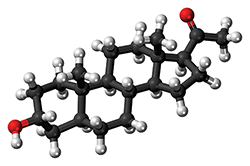The Unexpected
Calls for better screening, care, and treatment for perinatal depression are on the rise
- Feature

In the weeks after the birth of her son Owen, Australian writer Jessica Friedmann imagined her suicide: “I would walk out of the house, and cross the highway, leaving no sign behind me. Down the steep hill that led to the river’s banks, my hands would reach out for leaves and flowers, touching all the glossy, dew-specked marks of winter growth. Then I would slip out of my clothes, fold them neatly, and disappear beneath the surface of the water.”
In Things That Helped: On Postpartum Depression, Friedmann writes that knowing that her prior history of depression put her at risk for a recurrence during and after pregnancy, she did everything she could to prepare.
“I see my midwife regularly…alongside the psychiatrist, and together we make plans that are too firm to ever succeed. I will give birth; I will be healthy; I will love my newborn son.” Thirty percent of women who, like Friedmann, experienced depression before becoming pregnant risk its return with pregnancy.
Researchers and clinicians increasingly recognize that perinatal mood disorders have their beginnings during pregnancy, not just in the postpartum period.
“The nomenclature in the field has shifted,” says Leena Mittal, an HMS instructor in psychiatry, director of the Division of Women’s Mental Health at Brigham and Women’s Hospital, and associate medical director of the Massachusetts Child Psychiatry Advocacy Program (MCPAP) for Moms. “The term ‘perinatal depression,’ meaning ‘around pregnancy,’ fully encompasses depression during pregnancy and the postpartum period, and it can also include people who are struggling with pregnancy loss.”
Researchers who study perinatal depression are developing new theories of the disorder, improving our understanding of the variety of causes and symptoms that manifest, and designing new drug therapies. In the clinic, approaches to mental health care during and after pregnancy are beginning to be integrated into prenatal and postnatal care. Improved screening and education, in concert with collaborative models of mental health care for women during pregnancy, are starting to combat what Mittal calls “siloed care models.” These efforts are also helping to destigmatize perinatal depression.
Postpartum depression is the most common complication associated with childbirth, affecting nearly 18 percent of women worldwide.
Tipping points
The notion that pregnancy is a time of well-being has more to do with cultural mythology than biology. “Pregnancy is not protective from a mental-health standpoint,” says Edwin Raffi, an HMS instructor in psychiatry at Massachusetts General Hospital and a member of the MGH Center for Women’s Mental Health. It is, he says, a time of stress. “It can be good stress,” he notes, “but when you look at that allostatic load, the amount of stress your body can handle, if it goes over a certain threshold, then you’re really pushing the nervous system. Pregnancy can be a vulnerable time.”
Individuals who experience perinatal depression are a heterogeneous group that includes those who suffer from depression and become pregnant, those whose depression is in remission and who have a relapse during pregnancy, and those who become depressed for the first time while pregnant. Perinatal depression can occur more than a year after childbirth.

According to a 2018 systematic analysis of more than 200 studies from fifty-six countries published in Frontiers in Psychiatry, postpartum depression is the most common complication associated with childbirth, affecting nearly 18 percent of women worldwide. In addition, the analysis showed, countries with higher rates of income inequality and maternal and infant mortality as well as nations where women are more likely to work full-time have higher rates of depression surrounding pregnancy.
Research studies of U.S. populations have estimated that the prevalence of postpartum depressive disorder by state ranges from 8 to 20 percent, with an overall mean prevalence of 11.5 percent. Some of the clinical risk factors found include previous history of depression; pregnancy complications, such as gestational diabetes and preterm delivery; and pregnancy loss. Social factors, including low socioeconomic status, low levels of social or financial support, adolescent pregnancy, and intimate partner violence also were shown to put women at higher risk for perinatal depression.
Untreated maternal depression also places children at risk. “A baby cannot do well if a mother is not doing well,” says Mittal. Untreated or undertreated depression is associated with pregnancy complications including preeclampsia and preterm birth. A more important risk of depression that goes untreated, adds Mittal, is that it will worsen in the postpartum period and potentially affect mother-infant interactions.
According to some research studies, depressed mothers tend to stop breastfeeding early, and infants of depressed mothers receive less preventive health care. Perinatal depression can manifest in a variety of ways. Mothers might, for instance, be withdrawn from or have more volatile or intrusive engagements with their babies. Such behaviors disrupt parenting and put infants at risk for impaired mother-infant attachment; malnutrition; differences in emotional learning, language acquisition, and social development; and depression that can persist into adolescence.
Alike, yet different
The symptoms of perinatal depression are consistent with those of major depressive disorder, including depressed mood; fatigue; feelings of guilt, inadequacy, helplessness, or hopelessness; and suicidal thoughts. But, Mittal says, for some women “there are very distinct characteristics of perinatal depression.”

According to Kimberly Pearson, an HMS assistant professor of psychiatry and a staff psychiatrist at McLean Hospital, perinatal depression “tends to have more anxious or agitated symptoms, as well as intrusive or ruminating thinking.”
Some symptoms of depression—disrupted sleep, difficulty with self-care, and loss of appetite, for example—are also often part of the experience of taking care of a newborn.
Clinicians rely on a specialized evaluation tool, the Edinburgh Postnatal Depression Scale, to screen for perinatal depression, Mittal explains, because it can help distinguish symptoms of depression from the physical symptoms associated with pregnancy and the postpartum period. The interview questions in the Edinburgh scale, Mittal explains, are “genius” at zeroing in on perinatal-specific symptoms of depression, particularly self-blame, fear, anxiety, and anhedonia, or the inability to feel pleasure or enjoyment.
Treatment for perinatal depression depends on the timing and severity of symptoms and can involve antidepressant medications, primarily serotonin reuptake inhibitors as well as cognitive behavioral therapy and interpersonal psychotherapy. It can also include helping new mothers and their families cultivate stronger social supports and connections through mom-and-baby therapy or classes.
Perinatal depression is distinct from the baby blues, a period of what Mittal describes as “emotional reactivity,” which follows about ten to fourteen days after birth and affects about 75 to 80 percent of women. For the vast majority of women, Pearson says, the baby blues subside after about two weeks, but for some 20 percent of women, feelings of weepiness or of being overwhelmed and anxious can last longer and can evolve into postpartum depression.
There is no single cause of perinatal depression, and research to determine causes is “an active area,” says Mittal. “We are still trying to understand the biological underpinnings of the perinatal period and the abrupt changes associated with hormonal flux.”
Factor this in
Pregnancy is a complex biological event that affects the entire body. One potential driver of risk that researchers have found, Mittal says, is that the state of hormonal flux associated with pregnancy and with other reproductive hormone-governed conditions such as menarche and perimenopause may put one subset of women at higher risk for depression surrounding pregnancy. Thyroid function, sleep quality, and sleep deprivation may also contribute to mood changes. Genetic factors, such as a personal or family history of perinatal depression, can also contribute.
Recently, researchers have begun to look at how changes in the levels of certain neuroactive chemicals during pregnancy, particularly allopregnanolone, a metabolite of progesterone that rises during pregnancy and falls postpartum, affect neurotransmitters.
“We’re finding that there’s a connection between the endocrine system and neurotransmitters that can be a root cause,” says Raffi, “but this thinking is based on very new studies and very new theories.”
Those studies are already providing patients and clinicians with new treatment options. In March, the U.S. Food and Drug Administration approved brexanolone as an intravenous infusion therapy for the treatment of postpartum depression. This is the first therapy developed specifically for this disorder. Three randomized controlled trials of the drug, a synthetic version of allopregnanolone, showed that it improved symptoms demonstrably faster than selective serotonin reuptake inhibitors, the standard treatment to date. The drug’s manufacturer recently reported promising results for an oral form of the drug; 45 percent of patients experienced a remission of symptoms after two weeks of treatment.
ACOG recommended that postpartum care be integrated into prenatal care.
Systemic influences
Even when reproductive hormones and neurotransmitters are functioning normally, says Raffi, psychological, social, and environmental factors can all contribute to perinatal depression.
Pregnancy is as much a social experience as it is a biological one. It’s a time of change and transition, says Mittal, that leads to fluctuations in family structures and interpersonal dynamics. Layer the stress of such changes with genetic, biological, and social vulnerabilities, she adds, and perinatal depression can arise.
“We need to be sure that not just patients, but the people around them, from health care providers to family members, are educated so that we can improve screening, diagnosis, and treatment,” says Raffi.
Pearson would agree: “There’s been a big push from the perinatal mental health community to make mental health screening part of obstetric care.”
The organization Mittal helps direct is making strides in that direction. MCPAP for Moms was designed to provide perinatal psychiatric consultation and referral to mental health resources for obstetric, primary care, psychiatric, and pediatric providers throughout Massachusetts. An aim of this effort is to build these providers’ capacity to identify and manage mental health and substance use disorders in pregnant women through the first year after delivery. The organization recommends screening pregnant women for depression at three time points: during the first prenatal visit; at 26 to 28 weeks; and during the first postpartum visit, which usually occurs four to six weeks after birth.
Massachusetts is the first state to integrate screening for perinatal and maternal depression into prenatal and postpartum care, but initiatives of this type are developing elsewhere. MCPAP is leading efforts to help other states develop similar programs.
Last spring, the American College of Obstetricians and Gynecologists issued new recommendations on postpartum care. Because up to 40 percent of pregnant women do not attend a postpartum visit, ACOG recommended that postpartum care be integrated into prenatal care and that the first postpartum appointment be set for three weeks after delivery. In addition, ACOG recommended that the first postpartum appointment include screening for depression and anxiety.

In February, the U.S. Preventive Services Task Force, citing the short- and long-term negative effects of perinatal depression on mothers and children, the prevalence of the disorder, and the lack of clinical guidelines for its prevention, validated clinical research demonstrating that counseling interventions, such as cognitive behavioral therapy and interpersonal therapy, are effective in helping to prevent perinatal depression. Based on those findings, the task force, which works under the auspices of the U.S. Department of Health and Human Services to make evidence-based recommendations for clinical preventive services, recommended that clinicians provide or refer at-risk women for counseling. Programs cited as models included those that provide group counseling during pregnancy and postpartum and combine cognitive behavioral techniques with psychoeducation, stress management, and education to encourage positive mother-child attachment.
Raffi agrees with the task force’s recommendations but calls the guideline to screen high-risk patients “just the tip of the iceberg.” There are known risk factors indicating women who have a greater likelihood for developing perinatal depression. Yet despite available effective treatments for the condition, there is not yet a screening tool that can help predict the relationship between risk and developing perinatal depression. At the same time, there is a vital need for more mental health professionals to provide treatment.
When it comes to improving screening, education, and treatment, Raffi emphasizes the role of integrated care, from both health care providers and the community. Integrated care can mean having access to obstetricians, prenatal care, pediatricians, and well-baby care as well as social workers and mental health providers all in one place.
It can also mean seeing beyond the mother-child dyad to strengthen support around them. “I think the thing we don’t talk about enough is the role of the partner as well as families, employers, and communities in addressing mental health surrounding pregnancy,” he says.
“Many times,” he adds, “people around us who know us well can help detect changes that are happening to us even before we see or feel them ourselves. A patient’s spouse, family, employer, and community can be a great help in detecting a problem and being part of the solution. We spend a lot of time focusing on the mother and the child, but having a child should be a shared experience between the mother and everybody else, so we need to do a better job educating everyone to be active in facilitating care every step of the way. It really does take a village to support a happy family. We should involve the village.”
Andrea Volpe is a Massachusetts-based writer.
Images: John Soares; Creative Commons (chemical structure)